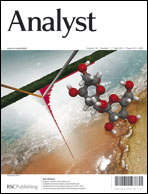Label-free colorimetric sensing of copper(ii) ions based on accelerating decomposition of H2O2 using gold nanorods as an indicator†
Abstract
A novel label-free colorimetric strategy was reported for sensitive detection of copper ions (Cu2+) by using the decelerating etching of gold nanorods (GNRs). H2O2 was employed as the oxidant for corrosion of GNRs, leading to the decrease of the aspect ratio of GNRs. In the absence of Cu2+, the redox corrosion of GNRs by H2O2 occurred rapidly, causing the distinct color change of GNRs from bluish green to purplish red. By virtue of the strong and specific catalysis by Cu2+ of the decomposition of H2O2, the rate of redox corrosion can be decelerated. Relevant experimental parameters, including pH value, concentrations of NaSCN and H2O2, incubation temperature and time were evaluated. Under optimal conditions, our method gave a good linear range of 10–300 nM (R = 0.9985) for Cu2+ and the detection limit with the naked eye is as low as 10 nM. Thus, the proposed colorimetric sensor is simple, sensitive (4.96 nM) and selective, and it has been successfully applied to detect Cu2+ in shellfish samples. Moreover, the potential mechanism was also discussed.


 Please wait while we load your content...
Please wait while we load your content...